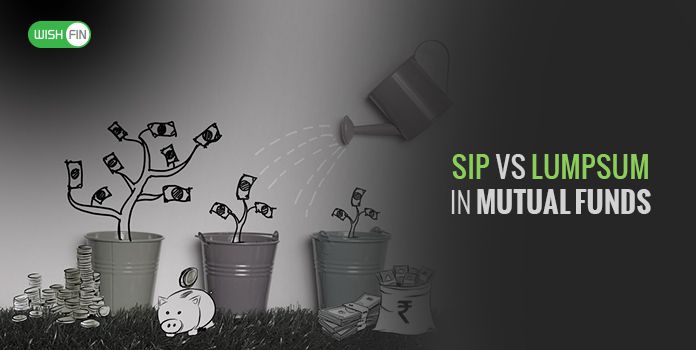SIP vs Lump Sum – Which Should You Opt for While Investing in ELSS?

Last Updated : Nov. 15, 2019, 11:45 a.m.
Want to invest in a product that can help you save tax and earn you more? Think of investing in an Equity-linked Savings Scheme (ELSS), a type of equity mutual fund scheme that offers the scope for greater returns on your investments by keeping the money predominantly in equity and equity-related instruments of companies. It helps you save tax upto ₹1.5 lakh under Section 80C of the Income Tax Act. There are two ways by which you can invest in ELSS – Systematic Investment Plan (SIP) and Lump Sum. But which one should you go for? To decide that, you must know the dynamics of both SIP and lump sum in this tax-saving investment. You can read this post to know the same.
So, What’s the Dynamics of SIP & Lump Sum in ELSS?
Firstly, you should know that ELSS comes with a lock-in period of 3 years, which means you can’t redeem your investments before the stated period. Going by that logic, you can easily redeem your lump sum proceeds after 3 years. But that won’t be the same when you invest in ELSS using the SIP route. As SIP investments happen periodically, you can redeem on an installment basis. An example below will help you understand the redemption better.
Example – You start investing ₹10,000 monthly via SIP in December 2019 and continue to do so for 10 years. You can thus redeem the SIP made in December 2019 in December 2022 and the one made in January 2020 in January 2023 and so on. In a nutshell, the entire investments can be withdrawn after 13 years.
What About the Tax Incidence? Will It be the Same in Both or Vary?
Let us clearly state that investments upto ₹1.5 lakh a year qualify for income tax exemptions under both SIP and lump sum in ELSS. Assuming you don’t make additional investments after investing a lump sum amount, you can avail tax exemption under 80C only in the first year. Whereas, in an SIP where investments happen periodically, you will continue to gain tax exemption till the time the investments are made.
But you will pay long-term capital gain tax at 10% on gains exceeding ₹1 lakh in either of the investment modes you choose to go with. The tax treatment will also depend on the redemption of units. Technically, with a lump sum, the units are accumulated at once and can be redeemed in full after 3 years of holding the same.
Let’s glance at the table below to understand lump sum returns better.
| Investment Aspects | Volume/Value |
|---|---|
| Investment Amount | ₹2,00,000 |
| Net Asset Value (NAV) | ₹100/Unit |
| Units Allotted | 2000 |
| Estimated Investment Value after 10 Years at an Assumed NAV of ₹300/Unit | 6,00,000 |
| Long-term Capital Gain (LTCG) | 4,00,000 (6,00,000-2,00,000) |
| LTCG Tax | (4,00,000-1,00,000) x 10% 30,000 |
| Net Gain | 3,70,000 (4,00,000-30,000)) |
If you start investing ₹10,000 monthly via SIP from January 2020 and continue to do so for 10 years, you can check the table below to understand the return calculation.
| SIP Period | Investment Amount (In ₹) | Assumed Net Asset Value (NAV) (In ₹/Unit) | Units Allotted | NAV After 3 Years of Investment at an Assumed 12% Growth Rate ((In ₹/Unit) | Redemption Value After 3 Years of Investment (In ₹) | Estimated Gains After 3 Years of Investment (In ₹) |
|---|---|---|---|---|---|---|
| January | 10000 | 100 | 100 | 112 | 11,200 | 1200 |
| February | 10000 | 120 | 83 | 134 | 11,122 | 1,122 |
| March | 10000 | 80 | 125 | 90 | 11,250 | 1,250 |
| April | 10000 | 90 | 111 | 101 | 11,211 | 1,211 |
| May | 10000 | 100 | 100 | 112 | 11,200 | 1,200 |
| June | 10000 | 95 | 105 | 106 | 11,130 | 1,130 |
| July | 10000 | 105 | 95 | 118 | 11,210 | 1,210 |
| August | 10000 | 110 | 91 | 123 | 11,193 | 1,193 |
| September | 10000 | 115 | 87 | 129 | 11,223 | 1,223 |
| October | 10000 | 100 | 100 | 112 | 11200 | 1,200 |
| November | 10000 | 120 | 83 | 134 | 11,122 | 1,122 |
| December | 10000 | 130 | 77 | 146 | 11,242 | 1,242 |
| Total Investment by the End of 2020 = 1,20,000 | Total Redemption Value by the End of 2023= 1,34,303 | Total Gain by the End of 2023 =14,303 |
Likewise, the pattern will continue.
Conclusion – From the point of saving income tax, SIP can help you do so year after year. With a lump sum, you can save tax in the first year only provided you don’t make additional investments. As far as convenience in redemption is concerned, lump sum is a better choice as you can redeem all your investments straight after 3 years. Having said that, a lot of us may not have a large sum to invest in one go. And, for those, an SIP might just be the option to go with.